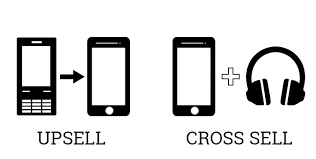Up-selling and Cross-selling: Its' meaning and importance to your business growth.
 Elakiwa
Elakiwa 
Upselling is a sales technique that encourages customers to spend more money by purchasing an upgraded or premium version of the product they originally intended to buy. It convinces a customer to purchase a more expensive version of a product or service. Companies that excel at upselling are effective at helping customers visualize the value they will get by ordering a higher-priced item.
Cross-selling on the other hand encourages customers to add related or complementary items to their existing purchases. Cross-selling identifies products that satisfy additional, complementary needs that are unfulfilled by the original item or service purchased.
Examples of Cross-selling:
A comb could be cross-sold to a customer purchasing a blow dryer.
In banks, Credit cards are cross-sold to people registering a savings account.
Life insurance is commonly suggested to customers buying car coverage. Etc
fig 1: A pictorial explanation of cross-selling and upselling
When to use the Upselling and Cross-selling Sales Techniques.
Opportunities to initiate upselling and Cross-selling exist at every stage of the customer lifecycle. This includes:
- Upselling Before Initial Sale:
Upselling and Cross-selling can be initiated as soon as a customer enters your store (whether online or physical store).
Use product pages for cheaper or more basic products to recommend premium or improved versions or related products via comparison charts. Or for a physical store, place upgraded versions or related products on the shelf next to a more basic product to catch the customer's attention.
- Upsell and Cross-sell at checkout:
Another perfect time is when a customer carts or is at the checkout page. This is a great place for Cross-selling related products, it can also be an effective tool for upselling. Try using your checkout page to inform buyers of offers that enhance their purchase, including volume discounts, personalization options, expedited shipping, gift wrapping, or enhanced protection.
3. Upsell after purchase:
Post-sales upselling allows customers to add upgrades to their orders. This is especially effective for software or digital assets, where it’s easy to add features or functionality. If you’re upselling a physical product, one way to upsell after a transaction is by offering customers an extended warranty or premium support for their purchase.
Cross-selling and upselling are similar in that they both focus on providing additional value to customers, instead of limiting them to already-encountered products. In both cases, the business objective is to increase order value and inform customers about additional product options they may not already know about. The key to success in both is to truly understand what your customer's value is and then respond with products and corresponding features that truly meet those needs.
In Conclusion, Upselling and cross-selling are mutually beneficial when done properly, providing maximum value to customers and increasing revenue without the recurring cost of many marketing channels.
The truth is that upselling and cross-selling are powerful and legitimate sales strategies for deepening customer relationships, enhancing the customer experience, and increasing revenue. But knowing when to cross-sell and upsell is much needed for it to be successful. Also, know that not all products or services can upsell and cross-sell to new customers. So products or services (typically SAAS) products have to be used by customers for some time to unlock their potential for an upsell.
Subscribe to my newsletter
Read articles from Elakiwa directly inside your inbox. Subscribe to the newsletter, and don't miss out.
Written by
